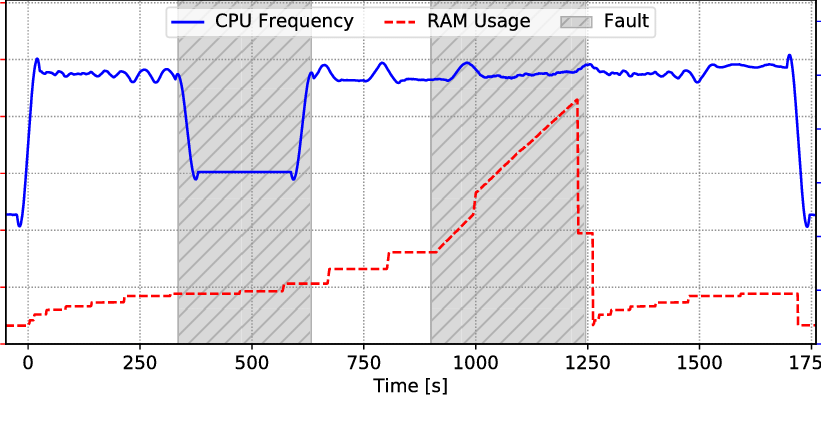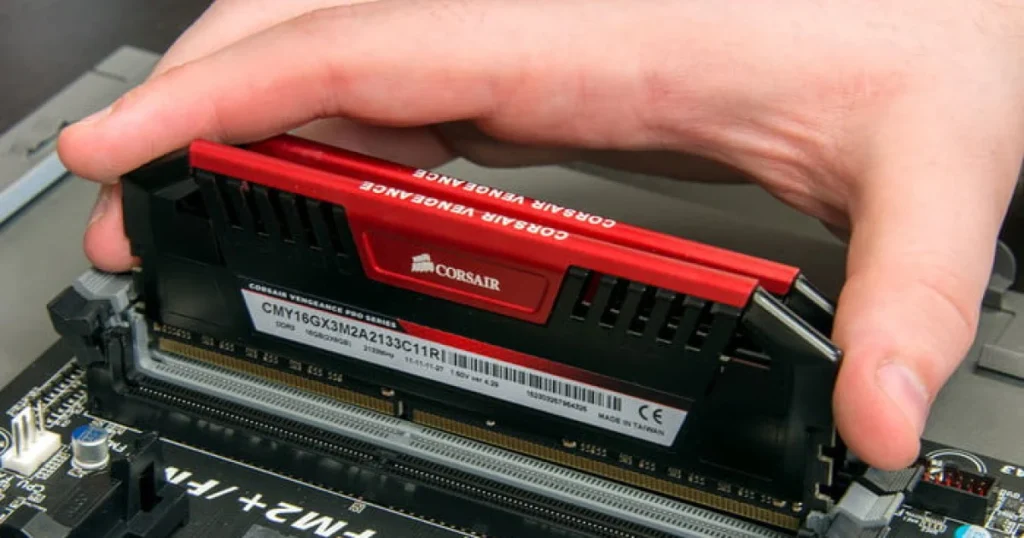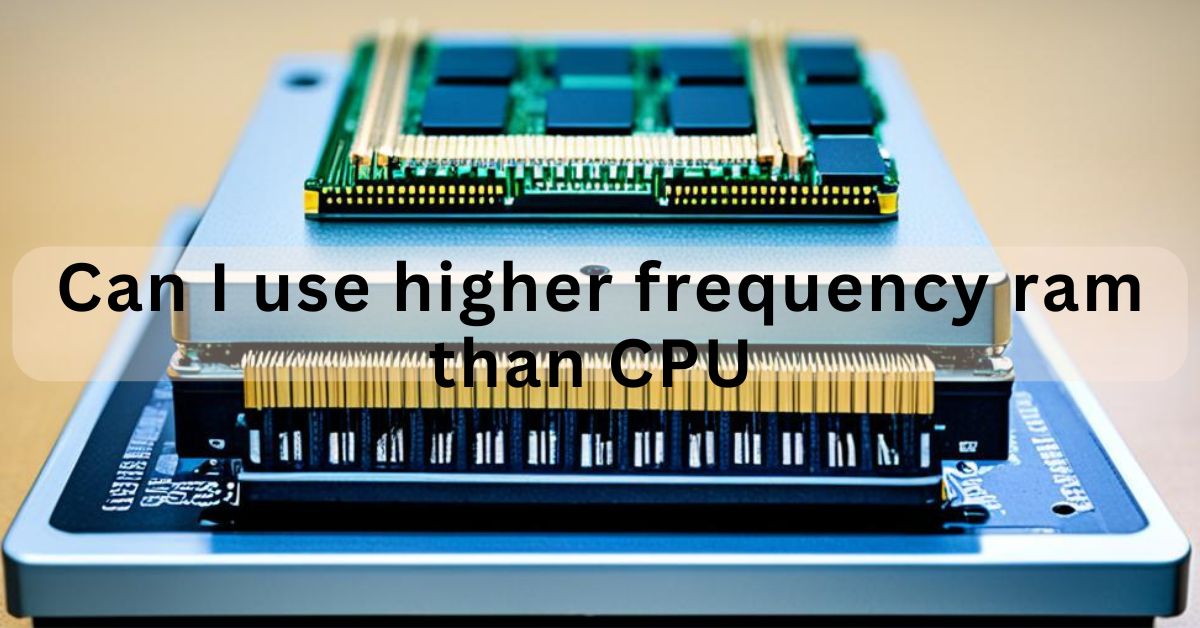When building or upgrading a computer, one common question that pops up is about RAM and CPU compatibility. Specifically, people often ask if they can use RAM with a higher frequency than their CPU supports. Understanding this aspect is crucial for ensuring optimal performance and stability in your system.
“Yes, you can use higher frequency RAM than your CPU supports, but the RAM will run at the maximum speed the CPU can handle. Check your motherboard compatibility too“
In this article we will discuss “can i use higher frequency ram than CPU”
Table of Contents
Understanding RAM and CPU Frequencies

RAM and CPU frequencies show how fast these parts work. RAM speed affects how quickly data is accessed, while CPU speed impacts processing power. Understanding these can help improve your computer’s performance
Explanation of RAM frequency
RAM frequency shows how fast the RAM can read and write data. Measured in megahertz (MHz), higher frequency means quicker data transfer, which can help your computer run faster and more efficiently
Explanation of CPU frequency
CPU frequency shows how fast the CPU processes instructions. Measured in gigahertz (GHz), a higher frequency means quicker execution of tasks, leading to better overall performance of your computer
Also Read: Why Does My CPU Fan Start And Stop – Complete Overview!
RAM and CPU Compatibility
RAM and CPU compatibility ensures that both components work well together. Check the motherboard specifications to match the RAM speed with the CPU’s capabilities, ensuring optimal performance and preventing potential issues.
How RAM and CPU work together
RAM and CPU work together by the CPU using RAM to quickly access and store data. The CPU processes tasks, while RAM provides the necessary data storage and retrieval, ensuring smooth and efficient computer performance.
Importance of compatibility
Compatibility is crucial because it ensures all computer parts work well together. If components like RAM and CPU are compatible, your system runs smoothly, avoids errors, and performs efficiently. Always check compatibility before upgrading.
Can You Use Higher Frequency RAM Than CPU?
Yes, you can use higher frequency RAM than the CPU supports, but the RAM will operate at the maximum speed the CPU can handle. This won’t harm your system, but you won’t get the full speed benefit of the RAM
The short answer
The short answer is a brief and concise response to a question, providing just enough information to address the query without additional details or explanations. It’s useful for quick, straightforward answers.
Detailed explanation
A detailed explanation provides in-depth information on a topic, covering all relevant aspects and answering potential questions. It helps readers fully understand the subject by including thorough descriptions, examples, and context.
Motherboard’s Role in RAM Frequency
The motherboard determines the maximum RAM frequency your system can support. It must match or exceed the RAM’s rated speed to ensure compatibility. Checking the motherboard specifications before upgrading RAM helps optimize performance and avoid compatibility issues.
How motherboard affects RAM speed

The motherboard dictates the maximum speed at which RAM can operate in a computer system. It must support the RAM’s rated speed to ensure optimal performance. Choosing a compatible motherboard allows you to take full advantage of your RAM’s capabilities without issues
Checking motherboard specifications
Checking motherboard specifications ensures compatibility with other components like RAM and CPU. It helps verify if the motherboard supports the desired RAM speed, CPU socket type, and other features necessary for building or upgrading a computer system
Impact on Performance
“Impact on performance” refers to how something affects how well a task or system operates. It’s about understanding the influence of changes or conditions on efficiency and results, whether positive, negative, or neutral, in straightforward terms.
Real-world performance impact
“Real-world performance impact” describes how something actually affects performance in practical situations. It assesses the tangible effects of changes or improvements on tasks or systems, considering how they perform in everyday use rather than in ideal conditions.
Also Read: Do I Need Two CPU Power Cables – A Complete Guide!
Scenarios where higher frequency RAM benefits
Higher frequency RAM benefits in scenarios where faster data processing is crucial, such as gaming, video editing, and multitasking. It enhances the speed at which information is accessed and manipulated, resulting in smoother performance and reduced lag during intensive tasks.
Overclocking
Overclocking means making computer components, like the CPU or GPU, run faster than their default settings. This can boost performance for tasks like gaming or editing, but it may also lead to increased heat and potentially reduce the lifespan of the hardware if not done cautiously.
What is overclocking?
Overclocking is when you make parts of your computer, like the CPU or GPU, work faster than they were designed to. This can improve performance in tasks like gaming or video editing but may also cause overheating if not managed carefully..
Risks and rewards
“Risks and rewards” refer to the potential dangers and benefits of a decision or action. It involves weighing the possible negative outcomes against the positive gains before making a choice, considering both the challenges and the potential advantages.
BIOS Settings
“BIOS settings” are configurations you can adjust in your computer’s basic input/output system. They control hardware operations like boot sequence and CPU settings. Accessible before the operating system loads, BIOS settings are crucial for optimizing performance and managing hardware compatibility.
Adjusting BIOS settings for RAM
To adjust BIOS settings for RAM, restart your computer, press the key shown during startup to enter BIOS, find the memory or RAM settings, and change the parameters like frequency or voltage according to your needs. Save and exit
Common BIOS settings for RAM configuration
Common BIOS settings for RAM configuration include adjusting the memory frequency, timing, and voltage. You can also enable XMP (Extreme Memory Profile) for automatic overclocking. These settings help optimize your computer’s performance and stability.
XMP Profiles
XMP profiles are pre-configured settings in the BIOS that automatically adjust your RAM to run at higher speeds. Enabling XMP can boost your computer’s performance without manually tweaking memory settings. Just activate it in the BIOS.
Explanation of XMP profiles
XMP profiles are built-in BIOS settings that optimize your RAM for better performance. By enabling XMP, your computer automatically adjusts memory speed, timing, and voltage to match the RAM’s capabilities. This makes your system faster and more efficient.
How to enable XMP profiles
To enable XMP profiles, restart your computer and press the key shown during startup to enter the BIOS. Find the memory or RAM settings, select the XMP option, and choose a profile. Save changes and exit.
Practical Tips for Choosing RAM

When choosing RAM, consider the type (DDR4, DDR5), capacity (at least 8GB for most users), speed (higher MHz is better), and compatibility with your motherboard and CPU. Also, check for low latency and reliable brands.
Tips for selecting the right RAM
When selecting RAM, ensure it is compatible with your motherboard, choose the right type (like DDR4 or DDR5), aim for at least 8GB, and consider higher speeds for better performance. Reliable brands and low latency are also important.
Balancing speed, latency, and cost
When balancing speed, latency, and cost for RAM, aim for a higher speed (MHz) for better performance, lower latency for faster response times, and a price within your budget. Look for reliable brands offering good value.
Also Read: Intel Lga 1151 CPU List – Best Intel LGA 1151 Processors!
Common Myths and Misconceptions
Common myths and misconceptions include thinking more RAM always means better performance, believing all RAM is the same, and assuming overclocking always improves speed. The truth depends on your specific needs and system compatibility.
Debunking myths about RAM frequency
Debunking myths about RAM frequency: higher frequency doesn’t always mean better performance. It depends on your CPU and motherboard compatibility. Also, real-world gains may be minimal for everyday tasks. Choose RAM based on your specific needs and system capabilities.
Common misunderstandings
Common misunderstandings about RAM include thinking all RAM speeds are critical for performance, assuming more RAM always improves speed, and believing all RAM brands offer the same reliability. Understanding your specific needs and system requirements is crucial for making informed decisions
Future-Proofing Your System
To future-proof your system, invest in sufficient RAM capacity and consider future software demands. Opt for a motherboard with upgrade options and choose RAM with good compatibility and potential for expansion. This prepares your system for upcoming technology advancements.
Planning for future upgrades
When planning for future upgrades, choose a motherboard and RAM with room for expansion. Consider your needs over time and invest in components that support future technology advancements, ensuring compatibility and performance as you grow your system.
Importance of choosing the right components
Choosing the right components is crucial for optimal performance and reliability. Well-matched components like RAM and motherboard ensure your system runs smoothly. This choice affects everything from speed to compatibility, enhancing your overall computing experience.
Case Studies
“Case studies” are real-life examples used to understand how something works in practice. They show us specific situations and outcomes, helping us learn from experiences. By examining these cases, we gain insights that can be applied to similar situations in the future.
Examples of different setups
“Examples of different setups” are instances that show various ways things can be arranged or organized. They provide different models or arrangements to illustrate how something can be done differently or in diverse ways, offering options for comparison or learning
Performance analysis
“Performance analysis” involves examining how well something is doing. It looks at factors like efficiency, effectiveness, and outcomes to understand strengths and weaknesses. This helps make decisions for improvement or to maintain success based on data and observations
Troubleshooting RAM Issues

“Troubleshooting RAM issues” means finding and fixing problems with computer memory. Common issues include crashes, errors, or slow performance. Solutions involve checking connections, testing modules, updating drivers, and ensuring compatibility with the motherboard to improve computer performance.
Common problems and solutions
“Common problems and solutions” refer to typical issues people encounter and ways to fix them. Examples include software glitches, hardware malfunctions, or connectivity troubles. Solutions often involve troubleshooting steps like restarting devices, updating software, checking cables, or adjusting settings to resolve issues efficiently.
Tools for diagnosing RAM issues
“Tools for diagnosing RAM issues” are software utilities that help find problems with computer memory. They test for errors, measure performance, and give information about how memory is used. Examples include MemTest86, Windows Memory Diagnostic, and CPU-Z, which help identify and fix RAM-related problems.
FAQs
Is it worth getting higher frequency RAM?
“Is it worth getting higher frequency RAM?” Higher frequency RAM can improve performance in tasks that benefit from faster memory access, like gaming or video editing. However, the actual benefits depend on other factors like CPU capabilities and software demands.
Can higher frequency RAM cause damage?
“Can higher frequency RAM cause damage?” Higher frequency RAM itself doesn’t cause damage if used within manufacturer specifications. However, overclocking beyond recommended limits can stress components and potentially lead to instability or reduced lifespan. Cooling and proper settings are crucial for safe operation.
How do I know the maximum RAM frequency my CPU supports?
To find the maximum RAM frequency your CPU supports, check the specifications provided by the CPU manufacturer. Look up your CPU model on their official website or consult the motherboard manual for details on supported RAM speeds and types.
What is the difference between RAM speed and latency?
RAM speed refers to how quickly data can be transferred, measured in MHz or GHz. Lower latency, measured in cycles (CL), indicates how quickly the RAM responds to requests. Higher speed improves overall bandwidth, while lower latency reduces delays in data access.
Can I mix different RAM frequencies?
Yes, you can mix different RAM frequencies, but they will all operate at the speed of the slowest module. For best performance and compatibility, it’s recommended to use RAM modules with similar speeds and timings whenever possible.
Conclusion
When considering RAM for your computer, it’s important to understand its impact on performance and compatibility with your CPU and motherboard. You can use higher frequency RAM than your CPU supports, but it will operate at the CPU’s maximum capability. Matching RAM speeds ensures optimal performance and stability in your system.
Recap of key points
“Recap of key points” summarizes important information briefly. It highlights critical details without going into extensive explanation. It’s useful for reviewing and reinforcing essential concepts discussed, ensuring clarity and understanding in a concise manner.
Final thoughts on RAM and CPU compatibility
RAM and CPU compatibility is crucial for smooth computer performance. Check the motherboard specifications to ensure they support the type and speed of RAM you plan to use. Matching these components correctly helps your system run faster and more efficiently.

